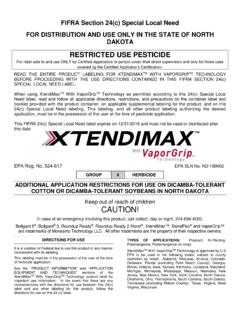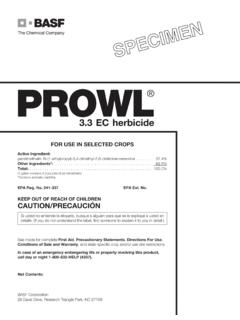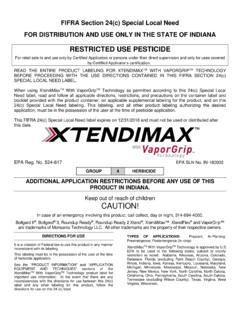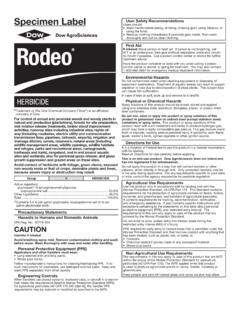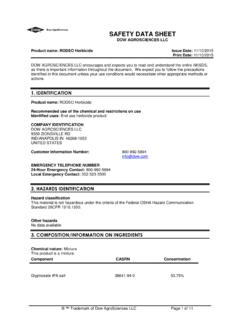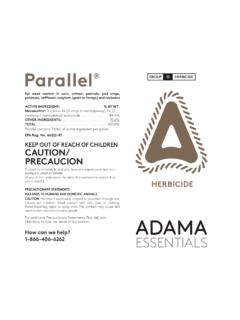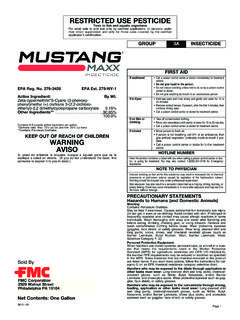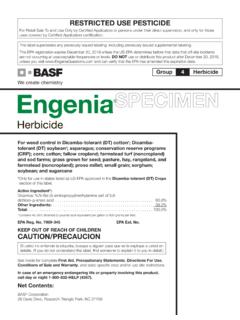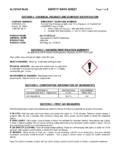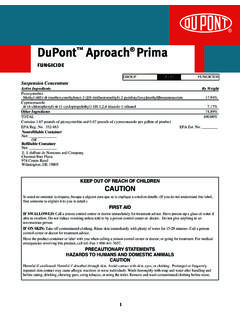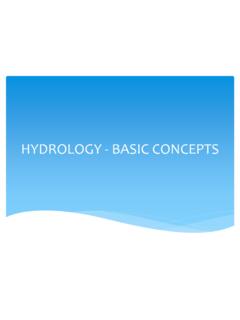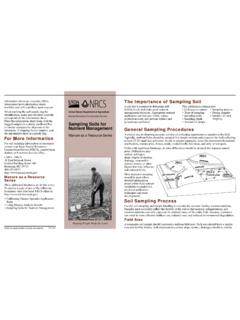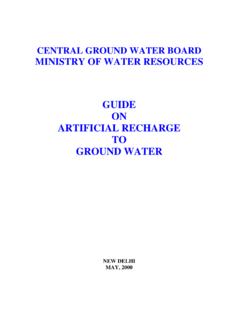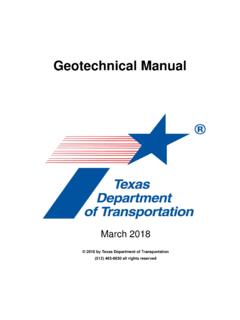Transcription of Alias 4F GROUP 4A INSECTICIDE
1 Flowable InsecticideFor use on a variety of listed agricultural and commercial INGREDIENT: % BY ; 1-[(6-Chloro-3-pyridinyl)methyl]-N-nitro -2-imidazolidinimine .. INGREDIENTS:.. 4 lbs. of active ingredient per gallonEPA Reg. No. 66222-156 EPA Est. No. 37429-GA-001BT; 37429-GA-002 BOLetter(s) in lot number correspond(s) to superscript in EPA Est. OUT OF REACH OF CHILDRENCAUTIONFor First Aid, Precautionary Statements, and Directions for Use, see inside of this can we help? 1-866-406-6262 Alias 4 FNet Contents1 gallonESSENTIALSINSECTICIDEGROUP4 AINSECTICIDE2 FIRST AIDIF SWALLOWED: Call a poison control center or doctor immediately for treatment advice.
2 Have person sip a glass of water if able to swallow. Do not induce vomiting unless told to do so by a poison control center or doctor. Do not give anything by mouth to an unconscious ON SKIN OR CLOTHING: Take off contaminated clothing. Rinse skin immediately with plenty of water for 15-20 minutes. Call a poison control center or doctor for treatment IN EYES: Hold eye open and rinse slowly and gently with water for 15-20 minutes. Remove contact lenses, if present, after the first 5 minutes, then continue rinsing eye.
3 Call a poison control center or doctor for treatment INHALED: Move person to fresh air. If person is not breathing, call 911 or an ambulance, then give artificial respiration, preferably mouth-to-mouth if possible. Call a poison control center or doctor for further treatment the product container or label with you when calling a poison control center or doctor or going for treatment. You may also contact PROSAR at 1-877-250-9291 for emergency medical treatment TO PHYSICIAN: No specific antidote is available.
4 Treat the patient STATEMENTSHAZARDS TO HUMANS AND DOMESTIC ANIMALSCAUTIONH armful if swallowed, absorbed through skin, or inhaled. Avoid contact with skin, eyes, or clothing. Avoid breathing vapor or spray mist. Wash thoroughly with soap and water after handling. Remove contaminated clothing and wash before PROTECTIVE EQUIPMENT (PPE)Applicators and other handlers must wear: Long-sleeved shirt and long pants Chemical-resistant gloves made of any waterproof material such as barrier laminate, butyl rubber, nitrile rubber, neoprene rubber, natural rubber, polyethylene, polyvinylchloride (PVC), or Viton Shoes plus socksFollow manufacturer s instructions for cleaning/maintaining personal protective equipment, PPE.
5 If no such instructions for washables, use detergent and hot water. Keep and wash PPE separately from other CONTROLS STATEMENTWhen handlers use closed systems, enclosed cabs, or aircraft in a manner that meets the requirements listed in the Worker Protection Standard (WPS) for agricultural pesticides [40 CFR (d)(4-6)], the handler PPE requirements may be reduced or modified as specified in the SAFETY RECOMMENDATIONSU sers should: Wash hands before eating, drinking, chewing gum, using tobacco, or using the toilet. Remove clothing/PPE immediately if pesticide gets inside.
6 Then wash thoroughly and put on clean clothing. Remove PPE immediately after handling this product. Wash the outside of gloves before removing. As soon as possible, wash thoroughly and change into clean HAZARDSDo not apply directly to water, to areas where surface water is present, or to intertidal areas below the mean high water mark. Do not contaminate water when disposing of equipment product is highly toxic to bees exposed to direct treatment or residues on blooming crops /plants or weeds. Do not apply this product or allow it to drift to blooming crops /plants or weeds if bees are foraging.
7 This product is toxic to wildlife and highly toxic to aquatic chemical demonstrates the properties and characteristics associated with chemicals detected in ground water. The use of this chemical in areas where soils are permeable, particularly where the water table is shallow, may result in ground water OF POLLINATORSAPPLICATION RESTRICTIONS EXIST FOR THIS PRODUCT BECAUSE OF RISK TO BEES AND OTHER INSECT POLLINATORS. FOLLOW APPLICATION RESTRICTIONS FOUND IN THE DIRECTIONS FOR USE TO PROTECT for the bee hazard icon in the Directions for Use for each application site for specifi c use restrictions and instructions to protect bees and other insect product can kill bees and other insect and other insect pollinators will forage on plants when they fl ower, shed pollen, or produce and other insect pollinators can be exposed to this pesticide from.
8 O Direct contact during foliar applications, or contact with residues on plant surfaces after foliar applicationso Ingestion of residues in nectar and pollen when the pesticide is applied as a seed treatment, soil, tree injection, as well as foliar Using This Product Take Steps To:o Minimize exposure of this product to bees and other insect pollinators when they are foraging on pollinator attractive plants around the application Minimize drift of this product on to beehives or to off-site pollinator attractive habitat.
9 Drift of this product onto beehives or off-site to pollinator attractive habitat can result in bee on protecting bees and other insect pollinators may be found at the Pesticide Environmental Stewardship website at: incidents (for example, bee kills) should immediately be reported to the state/tribal lead agency. For contact information for your state, go to: Pesticide incidents should also be reported to the National Pesticide Information Center at: or directly to EPA at: THE FOLLOWING PRECAUTIONS WHEN MIXING AND APPLYING IN THE VICINITY OF AQUATIC AREAS SUCH AS LAKES, RESERVOIRS, RIVERS, PERMANENT STREAMS, MARSHES OR NATURAL PONDS, ESTUARIES, AND COMMERCIAL FISH FARM DRIFT MANAGEMENTThe interaction of many equipment- and weather-related factors determine the potential for spray drift.
10 The applicator is responsible for considering all of these factors when making application decisions. Avoiding spray drift is the responsibility of the Aerial ApplicationsFor aerial applications, the spray boom should be mounted on the aircraft so as to minimize drift caused by wing tip vortices. The minimum practical boom length should be used, and must not exceed 75% of the wing span or rotor diameter. Spray should be released at the lowest possible height consistent with good pest control and flight safety. Applications more than 10 feet above the crop canopy should be of Droplet SizeAn important factor influencing drift is droplet size.
